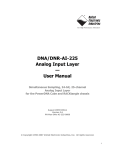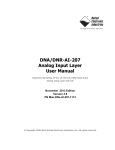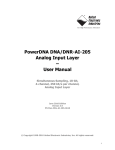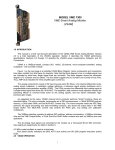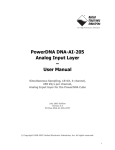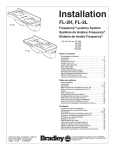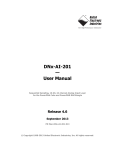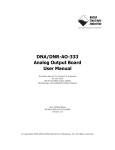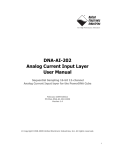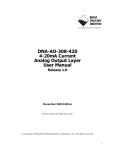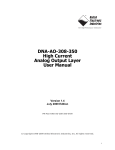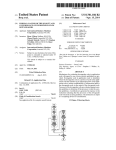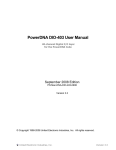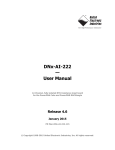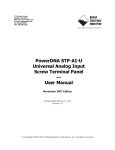Download AI 225 User Manual.book - United Electronic Industries
Transcript
PowerDNA DNA-AI-225 — User Manual Simultaneous Sampling, 24-bit, 25-channel Analog Input layer for the PowerDNA Cube June 2006 Edition Version 3.2 PN Man-DNA-AI-225-0606 © Copyright 1998-2007 United Electronic Industries, Inc. All rights reserved. i No part of this publication may be reproduced, stored in a retrieval system, or transmitted, in any form by any means, electronic, mechanical, by photocopying, recording, or otherwise without prior written permission. Information furnished in this manual is believed to be accurate and reliable. However, no responsibility is assumed for its use, or for any infringements of patents or other rights of third parties that may result from its use. All product names listed are trademarks or trade names of their respective companies. See UEI’s website for complete terms and conditions of sale: http://www.ueidaq.com/company/terms.aspx Contacting United Electronic Industries Mailing Address: 611 Neponset Street Canton, MA 02021 U.S.A. For a list of our distributors and partners in the US and around the world, please see http://www.ueidaq.com/partners/ Support: Telephone: Fax: (781) 821-2890 (781) 821-2891 Also see the FAQs and online “Live Help” feature on our web site. Internet Support: Support Web-Site FTP Site [email protected] www.ueidaq.com ftp://ftp.ueidaq.com Product Disclaimer: WARNING! DO NOT USE PRODUCTS SOLD BY UNITED ELECTRONIC INDUSTRIES, INC. AS CRITICAL COMPONENTS IN LIFE SUPPORT DEVICES OR SYSTEMS. Products sold by United Electronic Industries, Inc. are not authorized for use as critical components in life support devices or systems. A critical component is any component of a life support device or system whose failure to perform can be reasonably expected to cause the failure of the life support device or system, or to affect its safety or effectiveness. Any attempt to purchase any United Electronic Industries, Inc. product for that purpose is null and void and United Electronic Industries Inc. accepts no liability whatsoever in contract, tort, or otherwise whether or not resulting from our or our employees' negligence or failure to detect an improper purchase. ii 1 Table of Contents Chapter 1 Introduction .................................................... 1 1.1 Organization of this manual . . . . . . . . . . . . . . . . . . . . . . . . . . . . . . . . . . . . . . . . . . . . 1 1.2 The AI-225 Layer . . . . . . . . . . . . . . . . . . . . . . . . . . . . . . . . . . . . . . . . . . . . . . . . . . . . 3 1.3 Device architecture . . . . . . . . . . . . . . . . . . . . . . . . . . . . . . . . . . . . . . . . . . . . . . . . . . . 4 1.4 1.4.1 Layer Connectors and Wiring . . . . . . . . . . . . . . . . . . . . . . . . . . . . . . . . . . . . . . . . . . . 5 Wiring Diagrams for the AI-225 . . . . . . . . . . . . . . . . . . . . . . . . . . . . . . . . . . . . 6 1.5 1.5.1 Layer capabilities . . . . . . . . . . . . . . . . . . . . . . . . . . . . . . . . . . . . . . . . . . . . . . . . . . . . 7 Thermocouple Measurement . . . . . . . . . . . . . . . . . . . . . . . . . . . . . . . . . . . . . . 7 1.6 1.6.1 Data Representation . . . . . . . . . . . . . . . . . . . . . . . . . . . . . . . . . . . . . . . . . . . . . . . . . . 8 Software Calibration of this Layer . . . . . . . . . . . . . . . . . . . . . . . . . . . . . . . . . . 9 Chapter 2 Programming the High-Level API . . . . . . . . . . . . . . . . . . . . . . . . . . . . . . . . . . 11 2.1 Creating a session . . . . . . . . . . . . . . . . . . . . . . . . . . . . . . . . . . . . . . . . . . . . . . . . . . 11 2.2 Configuring the channels . . . . . . . . . . . . . . . . . . . . . . . . . . . . . . . . . . . . . . . . . . . . . 11 2.3 Configuring the Timing . . . . . . . . . . . . . . . . . . . . . . . . . . . . . . . . . . . . . . . . . . . . . . . 12 2.4 Reading Data . . . . . . . . . . . . . . . . . . . . . . . . . . . . . . . . . . . . . . . . . . . . . . . . . . . . . . 12 2.5 Cleaning-up the Session. . . . . . . . . . . . . . . . . . . . . . . . . . . . . . . . . . . . . . . . . . . . . . 12 Chapter 3 Programming with the Low-Level API . . . . . . . . . . . . . . . . . . . . . . . . . . . . . . 13 3.1 Configuration settings . . . . . . . . . . . . . . . . . . . . . . . . . . . . . . . . . . . . . . . . . . . . . . . . 13 3.2 Channel List Settings . . . . . . . . . . . . . . . . . . . . . . . . . . . . . . . . . . . . . . . . . . . . . . . . 14 3.3 Layer-specific Commands and Parameters . . . . . . . . . . . . . . . . . . . . . . . . . . . . . . . 14 3.4 Using the Layer in ACB Mode. . . . . . . . . . . . . . . . . . . . . . . . . . . . . . . . . . . . . . . . . . 15 3.5 Using Layer in DMap Mode . . . . . . . . . . . . . . . . . . . . . . . . . . . . . . . . . . . . . . . . . . . 17 Appendices A - Accessories . . . . . . . . . . . . . . . . . . . . . . . . . . . . . . . . . . . . . . . . . . . . . . . . . . . . . . . . . . . 19 DNA-CBL-62 . . . . . . . . . . . . . . . . . . . . . . . . . . . . . . . . . . . . . . . . . . . . . . . . . . . . . . . 19 DNA-STP-AI-U . . . . . . . . . . . . . . . . . . . . . . . . . . . . . . . . . . . . . . . . . . . . . . . . . . . . . 19 DNA-STP-62 . . . . . . . . . . . . . . . . . . . . . . . . . . . . . . . . . . . . . . . . . . . . . . . . . . . . . . . 19 DNA-5B-CONN . . . . . . . . . . . . . . . . . . . . . . . . . . . . . . . . . . . . . . . . . . . . . . . . . . . . . 19 B – Layer Calibration . . . . . . . . . . . . . . . . . . . . . . . . . . . . . . . . . . . . . . . . . . . . . . . . . . . . . . 19 Calibration Procedure . . . . . . . . . . . . . . . . . . . . . . . . . . . . . . . . . . . . . . . . . . . . . . . . . 19 C – Protection Circuits . . . . . . . . . . . . . . . . . . . . . . . . . . . . . . . . . . . . . . . . . . . . . . . . . . . . . 20 © Copyright 2007 United Electronic Industries, Inc. Date:04. 05. 2007 Vers: 3.2 File: AI 225 User ManualTOC.fm iv Table of Figures Chapter 1 Introduction . . . . . . . . . . . . . . . . . . . . . . . . . . . . . . . . . . . . . . . . . . . . . . . . . . . . 1 1-1 Block Diagram of the DNA-AI-225 Layer ....................................................................... 4 1-2 Pinout Diagram of the AI-225 Layer............................................................................... 5 © Copyright 2007 United Electronic Industries, Inc. Date:04. 05. 2007 Vers: Draft File: AI 225 User ManualLOF.fm DNA-AI-225 Layer Chapter 1 Introduction Chapter 1 Introduction This document outlines the feature-set and use of the AI-225 layer. This layer is an analog input module for the PowerDNA I/O Cube. 1.1 Organization This PowerDNA AI-225 User Manual is organized as follows: of this • Introduction Manual This chapter provides an overview of PowerDNA Analog Input Series board features, the various models available and what you need to get started. • The AI-225 layer This chapter provides an overview of the device architecture, connectivity, and logic of the AI-225 layer. • Programming with the High-Level API This chapter provides an overview of the how to create a session, configure the session for analog input, and interpret results on the AI-225 series layer. • Programming with the Low-Level API This chapter describes low-level API commands for configuring and using the AI-225 series layer. • Appendix A: Accessories This appendix provides a list of accessories available for AI-225 layer(s). • Appendix B: Calibration This appendix outlines layer calibration for the AI-225 series layer. • Index This is an alphabetical listing of the topics covered in this manual. Conventions To help you get the most out of this manual and our products, we use the following conventions: Tips are designed to highlight quick ways to get the job done, or to reveal good ideas you might not discover on your own. NOTE: Notes alert you to important information. © Copyright 2006 United Electronic Industries, Inc. Tel: 781-821-2890 Date: 04. 05. 2007 www.ueidaq.com Vers: 3.2 File: AI225Chapter1.fm 1 DNA-AI-225 Layer Chapter 1 Introduction CAUTION! Caution advises you of precautions to take to avoid injury, data loss, and damage to your boards or a system crash. Text formatted in bold typeface generally represents text that should be entered verbatim. For instance, it can represent a command, as in the following example: “You can instruct users how to run setup using a command such as setup.exe.” © Copyright 2006 United Electronic Industries, Inc. Tel: 781-821-2890 Date: 04. 05. 2007 www.ueidaq.com Vers: 3.2 File: AI225Chapter1.fm 2 DNA-AI-225 Layer Chapter 1 Introduction 1.2 AI-225 Layer Features The AI-225 layer has the following features: • 25 A/D simultaneously sampling converters with differential inputs • 24-bit resolution, ±1.25V input range • Bipolar range ±1.25V, AIn– and AIn+ within –0.25V–5.0V • Unipolar range –0.25V..1.25V, AIn– connected to AGND directly or via up to 10KOhm resistor • Input underrange/overrange over the ±1.25V range is detected by the software and reported © Copyright 2006 United Electronic Industries, Inc. • 5 S/s to 1000 S/s per channel sampling rates • >120dB rejection of AC component of 50/60Hz for sampling rates below 10Hz • >120dB Power Supply rejection ratio • Typical 120dB of common mode rejection • 120Hz –3dB analog front-end bandwidth • ±15V overvoltage and 2kV ESD protection at every input • One channel may be used for Cold Junction Compensation (CJC) • Entire analog front end isolated from digital circuitry • Direct Inputs for thermocouples • May be used with RTDs, may be used with external excitation source (voltage excitation is available on the STP-AI-U) • Strain gauge (bridge completion resistors required) • Input Impedance 100 Mohm • Input bias current ±15nA • Non-linearity 3ppm (0.0003%) • System noise 0.5μV RMS at 5Hz acquisition rate • Effective number of bits: 23.5 @ 5Hz down to 19 @ 1kHz • Input ground to system ground isolation: 350Vrms • Power consumption 3.9W max • SYNC interface option (allows external triggering) Tel: 781-821-2890 Date: 04. 05. 2007 www.ueidaq.com Vers: 3.2 File: AI225Chapter1.fm 3 DNA-AI-225 Layer Chapter 1 Introduction Figure 1-1 is a block diagram of the architecture of the AI-225 layer. ... AIn0AIn0+ DC/DC 24-bit A/D ... 24-bit A/D Calibration Reference Control Logic External Clocks and Triggers SRAM 32-bit 66-MHz bus Analog Input Connector AIn24+ Optical Isolation AIn24- Control Logic Device Architecture Protection/Buffers 1.3 Calibration EEPROM Figure 1-1 Block Diagram of the DNA-AI-225 Layer As shown in Figure 1-1, the AI-225 layer has an independent converter for each of the 25 channels. A differential input signal goes first to an auto-zero buffer/ amplifier with 125Hz –3dB bandwidth and then to an A/D converter. The A/D converter accepts signals within a –0.25 to 5V range and measures up to a ±1.25V difference between AIN+ and AIn–. This mode is called referenced bipolar differential because both AIn+ and AIn- are referenced to system ground. The AI-225 uses sigma-delta A/Ds that sample analog signals at 1.8MHz with a high over-sampling ratio and pass this data into decimating FIR filters. The oversampling ratio varies from 64 to 32768 for various sampling rates. This interworking of A/D converters allows the AI-225 to deliver true 24-bit resolution at a 5Hz data output rate down to 19-bit resolution at a 1 kHz rate. © Copyright 2006 United Electronic Industries, Inc. Tel: 781-821-2890 Date: 04. 05. 2007 www.ueidaq.com Vers: 3.2 File: AI225Chapter1.fm 4 DNA-AI-225 Layer Chapter 1 Introduction 1.4 Layer Connectors and Wiring The DNA-AI-225 layer supports referenced differential inputs only. Both signal and return line of the differential signal pair must have a potential within the range –0.25V to 5V, relative to isolated ground (AGND) level. Figure 1-2 illustrates the pinout of the AI-225. DB-62 (female) 62-pin connector: 62 61 60 59 58 57 56 55 54 53 52 51 50 49 48 47 46 45 44 43 DIO0 AIN1 AIN2 Return AIN4 AIN5 Return AIN7 AIN8 Return AIN10 AIN11 Return AIN13 AIN14 Return AIN16 AIN17 Return AIN19 AIN20 Return AIN22 AIN23 Return AGND DIO2 RESERVED 42 41 40 39 38 37 36 35 34 33 32 31 30 29 28 27 26 25 24 23 22 AGND AIN0 Return AIN2 AIN3 Return AIN5 AIN6 Return AIN8 AIN9 Return AIN11 AIN12 Return AIN14 AIN15 Return AIN17 AIN18 Return AIN20 AIN21 Return AIN23 AIN24 Return AGND RESERVED RESERVED 21 20 19 18 17 16 15 14 13 12 11 10 9 8 7 6 5 4 3 2 1 9V@20mA AIN0 AIN1 Return AIN3 AIN4 Return AIN6 AIN7 Return AIN9 AIN10 Return AIN12 AIN13 Return AIN15 AIN16 Return AIN18 AIN19 Return AIN21 AIN22 Return AIN24 9V@20mA DIO1 RESERVED Figure 1-2. Pinout Diagram of the AI-225 Layer © Copyright 2006 United Electronic Industries, Inc. Tel: 781-821-2890 Date: 04. 05. 2007 www.ueidaq.com Vers: 3.2 File: AI225Chapter1.fm 5 DNA-AI-225 Layer Chapter 1 Introduction 1.4.1 Wiring Diagrams for the AI-225 Table 1-1 shows examples of typical connection diagrams used with various types of input signals. Table 1-1. Analog Input Configurations — Differential Inputs (DI) Only Signal SourceType Floating Signal Source Input Configuration Grounded Signal Source Examples: Examples: • • • • Thermocouples Signal Conditioning with isolated outputs Battery devices Plug-in instruments with non-isolated inputs DNA-STP-96 or DNA-STP-AI-U Sig + - Vin RETx Ret AGND Differential AINx AINx + - Vin DNA-STP-96 or DNA-STP-AI-U AGND Two resistors (10kohm<R<100 kohm) provide return paths to ground for bias currents. See DNA-STP-AI-U jumpers (JDx/JGx/Nx). Sig + - Vin Ret AINx Single-ended Ground Referenced (not valid for standard AI-225) Not Used AGND Table 1-2. Analog Input Configurations — RTD, Bridge Wiring DNA-STP-96 or DNA-STP-AI-U +5V 20k 1K AInX+ RTD AInX– AGND © Copyright 2006 United Electronic Industries, Inc. Tel: 781-821-2890 Date: 04. 05. 2007 www.ueidaq.com Vers: 3.2 File: AI225Chapter1.fm 6 DNA-AI-225 Layer Chapter 1 Introduction 1.5 Layer Capabilities The AI-225 layer is capable of acquiring analog input voltages in ±1.25V range with gains of 1 at up to 24 bits of dynamic resolution (222nV RMS resolution). The layer is capable of generating its own CL (channel list) clock and trigger, and deriving them from either local external lines from its connector or from the SYNCx bus. Table 1-3. Gains Card Gain Range Noise, LSB Resolution. noise limited AI-225 1 ±V1.25 1.5‘ 222nV The aAnalog RC anti-aliasing filtering is tuned to provide roll-off at 1.5kHz (half of the maximum sampling frequency) as shown in Table 1-4 below. Table 1-4. Anti-Aliasing Filter Parameters Oversampl Frequency ing Ratio 1.5.1 Noise ENOBs ADC System ADC System 1000 128 3.5µV 5µV 20 18 800 256 2µV 3µV 21.3 21 400 512 1.4µV 2µV 21.8 21 200 1024 1µV 1.5µV 22.4 22 100 2048 750nV 1µV 22.9 22 50 4096 510nV 900nV 23.4 23 25 8192 375nV 700nV 24 24 10 16384 250nV 600nV 24.4 24 Thermocouple The AI-225 is capable of performing thermocouple measurements within 0.02°C Measurement at 10Hz per channel. The higher the speed of measurement, the more noise can be expected. The following table shows test results for noise for the AI-225 when used in conjunction with the STP-AI-U terminal (10Hz/ channel acquisition speed): Thermocouple Type P-p Noise, °C 100 Points RMS Noise, °C B 0.50 0.16 C 0.24 0.07 0.06 0.02 0.07 0.02 0.10 0.03 0.12 0.03 R 0.32 0.1 S 0.37 0.1 E J K N © Copyright 2006 United Electronic Industries, Inc. Tel: 781-821-2890 Date: 04. 05. 2007 Temperature Range Full Range of Thermocouples www.ueidaq.com Vers: 3.2 File: AI225Chapter1.fm 7 DNA-AI-225 Layer Chapter 1 Introduction Additional factors: 1.6 Data Representation • Open TC detection circuitry on the DNA-STP-AI-U adds ~15μV (±2μV) constant offset on all channels. (May be compensated using the CJC temperature sensor calibration. Channel-channel difference may be adjusted using the offset calibration simod 3 command.) • CJC sensor is calibrated to better than 0.2°C accuracy at room temperature • Stays within 0.4°C accuracy from –20 to +75°C temperature The AI-225 layer is equipped with 25 24-bit A/D converters. The layer can return 24-bit two’s complement data in 32-bit words, combined with levels on generalpurpose digital I/O lines. By default, if acquisition is not running, the output buffer is filled with relative addresses. On reset, every entry in the output buffer is filled with its relative position number. If you start receiving consecutive data from the layer (such as 0,1,2,..) it means that either the layer is not initialized properly or it is damaged. The following definition converts raw data from the converter into a 24-bit straight binary value: #define LT2440_GETVAL(V) (((V>>5)&0xffffff)^0x800000) To convert data into floating point, use the following formula (V is a result from the DQ_LT2440_GETVAL() macro): Volts = (V) * (2.5V/2^24) – 1.25V Raw 32-bit data received from converter is represented as: Reset State Bit Name Description 31 EOC Zero, if conversion is completed. 0 30 DMY Always low. 0 29 SIG Sign bit of the conversion. If VIN is > 0, this bit is NA HIGH. If VIN is < 0, this bit is LOW. 28 MSB Most significant bit of the result. If both Bit 29 and Bit 28 are HIGH, the differential input voltage is above +FS. If both Bit 29 and Bit 28 are LOW, the differential input voltage is below –FS. NA 27-5 LSB Less significant bits of the result. NA 5-3 © Copyright 2006 United Electronic Industries, Inc. SubLSB Sub LSB of the result beyond 24-bit level. Can be used in averaging. NA 1 DIO2 Level of DIO1 line (output). 0 1 DIO1 Level of DIO1 line (input). 0 0 DIO0 Level of DIO0 line (input). 0 Tel: 781-821-2890 Date: 04. 05. 2007 www.ueidaq.com Vers: 3.2 File: AI225Chapter1.fm 8 DNA-AI-225 Layer Chapter 1 Introduction 1.6.1 Software Calibration of this Layer Unlike most PowerDNA layers, the AI-225 relies on software calibration on the host side. The idea of layer calibration is to read, average, and store readings from all channels at zero volts and then at the fixed level (1V is the default level). By subtracting actual readings at zero volts from the ideal value (0x800000, straight binary) the software calculates calibration offsets. The firmware then subtracts the offset-adjusting value from the average value read at 1V. The result represents an offset-compensated reading at 1V. By dividing actual calibration voltage by offset-compensated reading, the software calculates the actual channel gain. When DQE opens the IOM, it automatically downloads calibration coefficients from each AI-225 in the PowerDNA cube by issuing DQCMD_RDFIFO commands with FIFO_GET_CAL FIFO channel. In return, the firmware sends a CALSET_225_ structure, which contains the gain calibration level and the averaged readings at zero volts and that level. Then, the software stores offset-adjusting values directly and calculates actual gain for every channel, as follows: cfvolt = (cvolt/ONEVOLTINNV); for (all channels) gain[i] = cfvolt/pcval[i]; You need to perform data calibration only when you configure and use the AI-225 layer directly, without DQE running. © Copyright 2006 United Electronic Industries, Inc. Tel: 781-821-2890 Date: 04. 05. 2007 www.ueidaq.com Vers: 3.2 File: AI225Chapter1.fm 9 DNA-AI-225 Layer Chapter 2 Programming the High-Level API Chapter 2 Programming the High-Level API This section describes how to program the PowerDNA AI-225 using the UeiDaq’s framework API. Since the UeiDaq Framework is object oriented, its objects can be manipulated in the same manner from different development environments such as Visual C++, Visual Basic, or LabVIEW. Although the following section focuses on the C++ API, the concept is the same no matter what programming language you use. Please refer to the “UeiDaq Framework User Manual” for more information on using other programming languages. 2.1 Creating a Session The Session object controls all operations on your PowerDNA device. The first task, therefore, is to create a session object, as follows: CUeiSession session; 2.2 Configuring the Channels Framework uses resource strings to select which device, subsystem, and channels to use within a session. The resource string syntax is similar to a web URL: <device class>://<IP address>/<Device Id>/<Subsystem><Channel list> For PowerDNA the device class is pdna. For example, the following resource string selects analog input channels 0,2,3,4 on device 1 at IP address 192.168.100.2: “pdna://192.168.100.2/Dev1/Ai0,2,3,4” The session object’s method “CreateAIChannel” is used to configure the channel list, gain, and signal referencing mode. The gain and input mode parameters are ignored when using an AI-225 because it doesn’t have programmable gain and is differential only). // Configure session to acquire from channels 0 and 1 session.CreateAIChannel(“pdna://192.168.100.2/Dev0/Ai0,1”, -0.15, 0.15, UeiAIChannelInputModeDifferential); The AI-225 offers very good accuracy, thanks to its 24-bit A/D converters and its dedicated channel for measuring the Cold Junction Compensation temperature sensor. Therefore, it is well suited for measuring temperature with thermocouples. The session object’s method “CreateTCChannel” is used to configure the channels, thermocouple type, CJC sensor, and temperature scale. You can use thermocouples of type E, J, K, R, S, T, B or N. You can measure the CJC temperature either by using a sensor integrated in the terminal block or by specifying a constant. You can measure temperature in degrees Celsius, Fahrenheit, Kelvin, or Rankine. // Configure the session to acquire temperatures in degrees © Copyright 2007 United Electronic Industries, Inc. Tel: 781-821-2890 Date: 04. 05. 2007 www.ueidaq.com Vers: 3.2 File: AI225Chapter2.fm 10 DNA-AI-225 Layer Chapter 2 Programming the High-Level API // Celsius from channels 0 and 1 using K thermocouples. // Use the built-in CJC sensor session.CreateTCChannel(“pdna://192.168.100.2/Dev0/Ai0,1”, -100.0, 100.0, UeiThermocoupleTypeK, UeiTemperatureScaleCelsius, UeiCJCTypeBuiltIn, 0.0, “”, UeiAIChannelInputModeDifferential); 2.3 Configuring the Timing You can configure the AI-225 to run in simple mode (point by point) or buffered mode (ACB mode). In simple mode, the delay between samples is determined by software on the host computer. In buffered mode, the delay between samples is determined by the AI-225 onboard clock. The following sample shows how to configure the simple mode. Please refer to the “UeiDaq Framework User Manual” to learn how to use the other timing modes. session.ConfigureTimingForSimpleIO(); 2.4 Reading Data Reading data from the AI-225 is done using a reader object. There is a reader object to read raw data coming straight from the A/D converter. There is also a reader object to read data already scaled to volts or temperatures. The following sample code shows how to create a scaled reader object and read samples. // Create a reader and link it to the session’s stream CueiAnalogScaledReader reader(session.GetDataStream()); // read one scan, the buffer must be big enough to contain // one value per channel double data[2]; reader.ReadSingleScan(data); 2.5 Cleaning-up the Session The session object cleans itself up when it goes out of scope or when it is destroyed. However, to reuse the object with a different set of channels or parameters, you can also clean up the session manually. session.CleanUp(); © Copyright 2007 United Electronic Industries, Inc. Tel: 781-821-2890 Date: 04. 05. 2007 www.ueidaq.com Vers: 3.2 File: AI225Chapter2.fm 11 DNA-AI-225 Layer Chapter 3 Programming with the Low-Level API Chapter 3 Programming with the Low-Level API This section describes how to program the PowerDNA cube using the low-level API. The low-level API offers direct access to PowerDNA DAQBios protocol and also allows you to directly access device registers. We recommend that you use the UeiDaq Framework (see Chapter 2), because it is easier to use. You should only need to use the low-level API if you are using an operating system other than Windows. 3.1 Configuration Configuration setting are passed in DqCmdSetCfg() and DqAcbInitOps() functions. Settings Note that not all configuration bits apply to AI-225 layer. The following bits make sense: #define DQ_FIFO_MODEFIFO (2L << 16) // continuous acquisition with FIFO #define DQ_LN_MAPPED (1L<<15) #define DQ_LN_STREAMING (1L<<14) // For WRRD (DMAP) devices // For RDFIFO devices - stream the // FIFO data automatically // For WRFIFO - do NOT send reply // to WRFIFO unless needed #define DQ_LN_IRQEN (1L<<10) // enable layer irqs #define DQ_LN_PTRIGEDGE1 (1L<<9) #define DQ_LN_PTRIGEDGE0 (1L<<8) // stop trigger edge MSB // stop trigger edge: // 00 - software, // 01 - rising, 02 - falling #define DQ_LN_STRIGEDGE1 (1L<<7) #define DQ_LN_STRIGEDGE0 (1L<<6) // start trigger edge MSB // start trigger edge: // 00 -software, 01 - rising, // 02 - falling #define DQ_LN_CVCKSRC1 (1L<<5) // CV clock source MSB #define DQ_LN_CVCKSRC0 (1L<<4) // CV clock source 01 - SW, 10 - HW, 11 -EXT #define DQ_LN_CLCKSRC1 (1L<<3) // CL clock source MSB #define DQ_LN_CLCKSRC0 (1L<<2) // CL clock source 01 - SW, 10 - HW, 11 -EXT #define DQ_LN_ACTIVE (1L<<1) // "STS" LED status #define DQ_LN_ENABLED (1L<<0) // enable operations For streaming operations with hardware clocking, select the following flags: DQ_LN_ENABLE | DQ_LN_CVCKSRC0 | DQ_LN_STREAMING | DQ_LN_IRQEN | DQ_LN_ACTIVE DQ_LN_ENABLE enables all operations with the layer. DQ_LN_CVCKSRC0 selects the internal channel list clock (CL) source as a timebase. The AI-225 supports CV clock. DQ_LN_ACTIVE is needed to switch on the “STS” LED on the CPU layer. You can select either the CL or CV clock as a timebase. Because of the parallel architecture of AI-225 layer, either clock triggers all converters. Aggregate rate = Per-channel rate * Number of channels © Copyright 2007 United Electronic Industries, Inc. Tel: 781-821-2890 Date: 04. 05. 2007 www.ueidaq.com Vers: 3.2 File: AI225Chapter3.fm 12 DNA-AI-225 Layer Chapter 3 Programming with the Low-Level API Acquisition rate cannot be selected on per-channel basis. To select a different resulting rate for a different channel, program the proper decimators in the FIR unit. 3.2 Channel List The AI-225 layer has a very simple channel list structure, as shown in the table below.: Settings Bit Name 31 DQ_LNCL_NEXT Tells firmware there is a “next” entry in the channel list. 20 DQ_LNCL_TSRQ Request timestamp as a next data point 7..0 3.3 Layerspecific Commands and Parameters Purpose Channel number Layer-specific functions are described in the DaqLibHL.h file. DqAdv225Read() This function works using underlying DqReadAIChannel(), but converts the data using internal knowledge of the input range and calibrates every channel. It uses DQCMD_IOCTL with DQIOCTL_CVTCHNL under the hood. When this function is called for the first time, the firmware stops any ongoing operation on the device specified and reprograms it according to the channel list supplied. This function uses the preprogrammed CL update frequency — 13.75Hz. You can reprogram the update frequency by calling DqCmdSetClk()after the first call to DqAdv225Read(). Therefore, you cannot perform this function call when the layer is involved in any streaming or data mapping operations. If you specify a short timeout delay, this function can time out when called for the first time because it is executed as a pending command and layer programming takes up to 10ms. Once this function is called, the layer continuously acquires data and every call to the function returns the latest acquired data. If you want to cancel ongoing sampling, call the same function with 0xFFFFFFFF as a channel number. © Copyright 2007 United Electronic Industries, Inc. Tel: 781-821-2890 Date: 04. 05. 2007 www.ueidaq.com Vers: 3.2 File: AI225Chapter3.fm 13 DNA-AI-225 Layer Chapter 3 Programming with the Low-Level API 3.4 Using the Layer in ACB Mode The following is a pseudo-code example that highlights the functions needed in sequence to use ACB on the 225 layer. A complete example with error checking can be found in the directory SampleACB205. #include "PDNA.h" // unit configuration word #define CFG225 (DQ_LN_ENABLED \ |DQ_LN_ACTIVE \ |DQ_LN_GETRAW \ |DQ_LN_IRQEN \ |DQ_LN_CLCKSRC0 \ |DQ_LN_STREAMING \ |DQ_AI225_MODEFIFO) uint32 Config = CFG225; STEP 1: Start DQE engine. #ifndef _WIN32 DqInitDAQLib(); #endif // Start engine DqStartDQEngine(1000*1, &pDqe, NULL); // Open communication with IOM hd0 = DqOpenIOM(IOM_IPADDR0, DQ_UDP_DAQ_PORT, TIMEOUT_DELAY, &RdCfg); // Receive IOM crucial identification data DqCmdEcho(hd0, DQRdCfg); // Set up channel list for (n = 0; n < CHANNELS; n++) { CL[n] = n; } STEP 2: Create and initialize host and IOM sides. // Now we are going to test device DqAcbCreate(pDqe, hd0, DEVN, DQ_SS0IN, &bcb); // Let’s assume that we are dealing with AI-201 device dquser_initialize_acb_structure(); // Now call the function ret = DqAcbInitOps(bcb, © Copyright 2007 United Electronic Industries, Inc. Tel: 781-821-2890 Date: 04. 05. 2007 www.ueidaq.com Vers: 3.2 File: AI225Chapter3.fm 14 DNA-AI-225 Layer Chapter 3 Programming with the Low-Level API &Config, 0, //TrigSize, NULL, //pDQSETTRIG TrigMode, &fCLClk, 0, //float* fCVClk &CLSize, CL, 0, //uint32* ScanBlock, &acb); printf("Actual clock rate: %f\n", fCVClk); // Now set up events DqeSetEvent(bcb, DQ_eFrameDone|DQ_ePacketLost|DQ_eBufferError|DQ_ePacketOOB); STEP 3: Start operation. // Start operations DqeEnable(TRUE, &bcb, 1, FALSE); STEP 4: Process data. // We will not use event notification at first - just retrieve scans while (keep_looping) { DqeWaitForEvent(&bcb, 1, FALSE, EVENT_TIMEOUT, &events); if (events & DQ_eFrameDone) { minrq = acb.framesize; avail = minrq; while (TRUE) { DqAcbGetScansCopy(bcb, data, acb.framesize, acb.framesize, &size, &avail); samples += size*CHANNELS; for (i = 0; i < size * CHANNELS; i++) { fprintf(fo, "%f\t", *((float*)data + i)); if ((i % CHANNELS) == (CHANNELS - 1)) { fprintf(fo, "\n"); } } printf("eFD:%d scans received (%d samples) min=%d avail=%d\n", size, samples, minrq, avail); if (avail < minrq) { break; } } } © Copyright 2007 United Electronic Industries, Inc. Tel: 781-821-2890 Date: 04. 05. 2007 www.ueidaq.com Vers: 3.2 File: AI225Chapter3.fm 15 DNA-AI-225 Layer Chapter 3 Programming with the Low-Level API } STEP 5: Stop operation. DqeEnable(FALSE, &bcb, 1, FALSE); STEP 6: Clean up. DqAcbDestroy(bcb); DqStopDQEngine(pDqe); DqCloseIOM(hd0); #ifndef _WIN32 DqCleanUpDAQLib(); #endif 3.5 Using Layer in DMap Mode #include "PDNA.h" STEP 1: Start DQE engine #ifndef _WIN32 DqInitDAQLib(); #endif // Start engine DqStartDQEngine(1000*10, &pDqe, NULL); // open communication with IOM hd0 = DqOpenIOM(IOM_IPADDR0, DQ_UDP_DAQ_PORT, TIMEOUT_DELAY, &DQRdCfg); // Receive IOM crucial identification data DqCmdEcho(hd0, DQRdCfg); for (i = 0; i < DQ_MAXDEVN; i++) { if (DQRdCfg->devmod[i]) { printf("Model: %x Option: %x\n", DQRdCfg->devmod[i], DQRdCfg->option[i]); } else { break; } } STEP 2: Create and initialize host and IOM sides. DqDmapCreate(pDqe, hd0, &pBcb, UPDATE_PERIOD, &dmapin, &dmapout); STEP 3: Add channels into DMap. © Copyright 2007 United Electronic Industries, Inc. Tel: 781-821-2890 Date: 04. 05. 2007 www.ueidaq.com Vers: 3.2 File: AI225Chapter3.fm 16 DNA-AI-225 Layer Chapter 3 Programming with the Low-Level API for (i = 0; i < CHANNELS; i++) { DqDmapSetEntry(pBcb, DEVN, DQ_SS0IN, i, DQ_ACB_DATA_RAW, 1, &ioffset[i]); printf("offset%d = 0x%x\n", i, (uint32)ioffset[i]); } DqDmapInitOps(pBcb); DqeSetEvent(pBcb, DQ_eDataAvailable|DQ_ePacketLost|DQ_eBufferError|DQ_ePacketOOB); STEP 4: Start operation. DqeEnable(TRUE, &pBcb, 1, FALSE); STEP 5: Process data. while (keep_looping) { DqeWaitForEvent(&pBcb, 1, FALSE, timeout, &eventsin); if (eventsin & DQ_eDataAvailable) { printf("\ndata "); for (i = 0; i < CHANNELS; i++) { printf("%08x ", *(uint32*)ioffset[i]); } } } STEP 6: Stop operation. DqeEnable(FALSE, &pBcb, 1, FALSE); STEP 7: Clean up. DqDmapDestroy(pBcb); DqStopDQEngine(pDqe); DqCloseIOM(hd0); #ifndef _WIN32 DqCleanUpDAQLib(); #endif © Copyright 2007 United Electronic Industries, Inc. Tel: 781-821-2890 Date: 04. 05. 2007 www.ueidaq.com Vers: 3.2 File: AI225Chapter3.fm 17 DNA-AI-225 Layer Appendices A - Accessories The following cables and STP boards are available for the AI-201 layer. DNA-CBL-62 2.5ft, 62-way round shielded cable DNA-STP-AI-U Universal PowerDNA Analog Input Terminal Panel DNA-STP-62 62-channel screw terminal panel DNA-5B-CONN 24-channel signal-conditioning mating panel B – Layer Calibration Note that once you perform layer calibration yourself, factory calibration warranty is void. Calibration should be performed with microvolt-resolution precision voltage source with low (1 Ohm or less) output impedance. Calibration assumes use of the single-ended mode, where all channels have the same signal and return levels. Please tie AGND to the common return of all channels with a 10k resistor to keep it closer to the common mode level. To perform layer calibration, you should have a precision voltage source attached to all twenty-five channels and run a serial terminal program attached to the IOM serial port. Use the “simod 1” command to calibrate the layer. Calibration Procedure (using serial port terminal): STEP 1: Apply 0V on all channels STEP 2: Type “simod 1” STEP 3: From the device table, select the proper device to be calibrated . The firmware will ask you to apply 0V and press Enter when this is done. The firmware then acquires multiple scans for averaging within ten seconds. The firmware will ask you to apply 1V and press Enter when this is done. STEP 4: Apply 1V and press Enter. The firmware then acquires multiple scans for averaging within ten seconds. The firmware calculates the offset adjustment and gain and displays them. For a normally working layer, the gain should be within 151..156 nV/bit. Values outside this range suggest either high noise levels, problems with the voltages applied, or a hardware problem with the layer. STEP 5: Press “Esc” and reply “y” if you want to save the calibration values into E2PROM. STEP 6: To verify calibration, reset the PowerDNA cube. NOTE: The AI-225 layer is extremely sensitive (1bit = 152nV) and can react to your movements near voltage source cabling and input connectors. We recommend locating the voltage source and PowerDNA cube being © Copyright 2006 United Electronic Industries, Inc. Tel: 781-821-2890 Date: 04. 05. 2007 www.ueidaq.com Vers: 3.2 File: AI225Appx.fm 18 DNA-AI-225 Layer calibrated as far away from the operator and sources of EM noise as possible. We also recommend calibrating the offset by applying 0 volts from the signal source rather than by shorting inputs You can verify calibration after resetting the PowerDNA cube by using the same “simod 1” routine, but do not save the results at the end. “simod 2” shows raw acquired data without filtering as well as RMS and delta readings. For AI-225 layers, we recommend annual factory recalibration at UEI C – Protection Circuits At times, the signal being measured appears to clip when attempting to measure what appear to be normal voltages. Clipping is a sign of tripping the protection circuitry of the layer, which is designed to protect layer components from damage by high voltage. This can happen under a variety of conditions, such as a different potential for the AI-225’s ground vs. the chassis of the instrument (this can be fixed by connecting the chassis to the AGND line on the STP-AI-U). Given the variables: Let VEE = 0V (this is AGND) Let VCC = 5V (or anywhere between 4.75V to 5.25V, depending on the P.S.U.) Breaking the following rules activates the protection circuitry: 1. VCC + 0.25V > VIN(-) > VEE – 0.25V VCC + 0.25V > VIN(+) > VEE – 0.25V 2. | VIN(-) – VIN(+) | < 1.25V © Copyright 2006 United Electronic Industries, Inc. Tel: 781-821-2890 Date: 04. 05. 2007 www.ueidaq.com Vers: 3.2 File: AI225Appx.fm 19 20 Index A A/D Converters 3 A/D Resolution 3 Accessories 18 Anti-Alias Filtering Architecture 4 B Block Diagram C G Gains H High-Level API 7 I L Layer Commands and Parameters Low-Level API 12 Calibration 9 How-to 18 calibration How-to 19 Calibration Procedure 18 Capabilities 7 Channel List Settings 13 Channel List Structure 13 Cleaning-up the Session 11 Configuration Bits 12 Configuration Settings 12 Configuring Channels 10 Configuring Timing 11 Connectors and Wiring 5 Conventions 1 Creating a Session 10 Data Representation E ESD Protection F Features M Mailing Address Mode ACB 14 DMap 16 13 ii O Organization 1 Overvoltage Protection 3 P Pinout 5 Product Disclaimer R Reading Data S ii 11 Sampling Rate 3 Software Calibration Support ii 8 9 T 3 Thermocouple Measurement W 3 © Copyright 2007 United Electronic Industries, Inc. 10 Input Configurations 6 Internet Support ii 4 D 7 Wiring Diagrams Tel: 781-821-2890 Date: 04. 05. 2007 7 6 www.ueidaq.com File: Vers: 1.0 AI 225 User ManualIX.fm
























